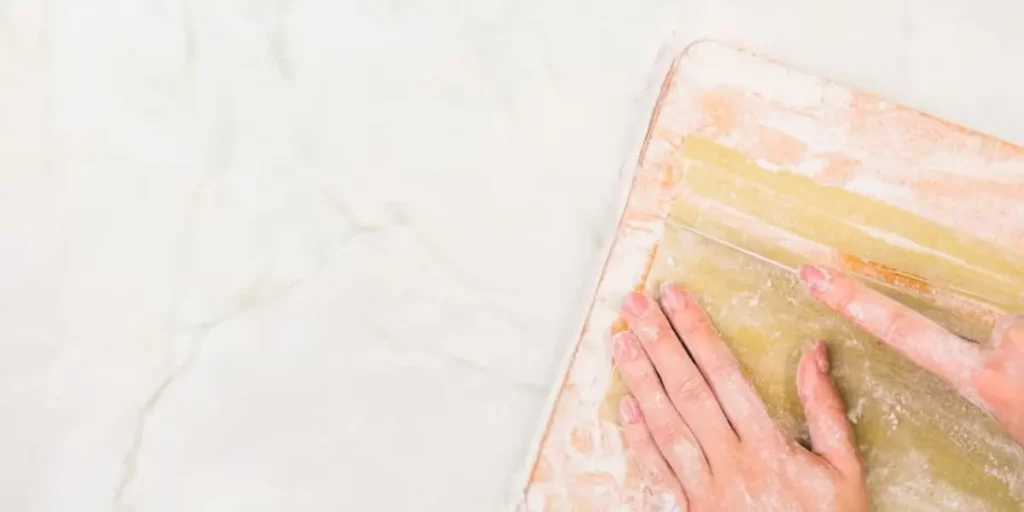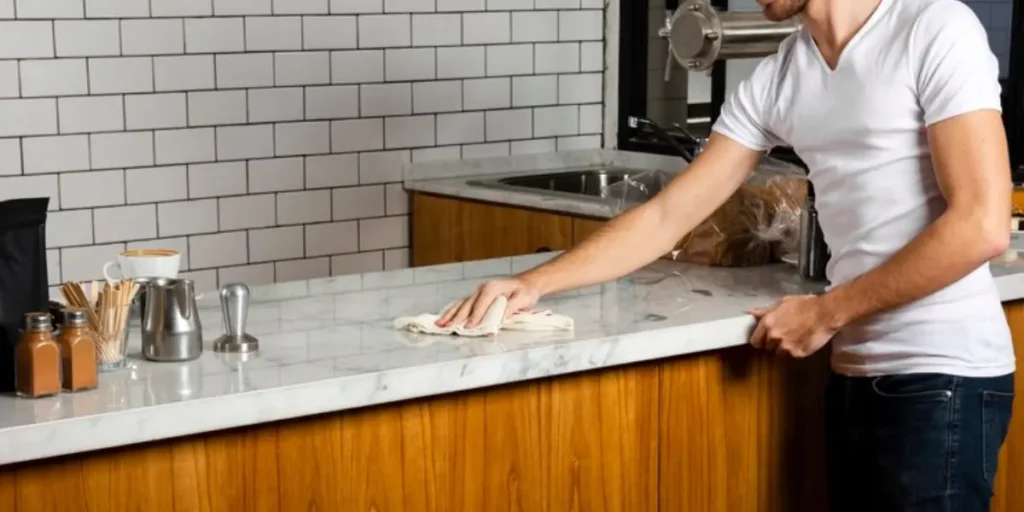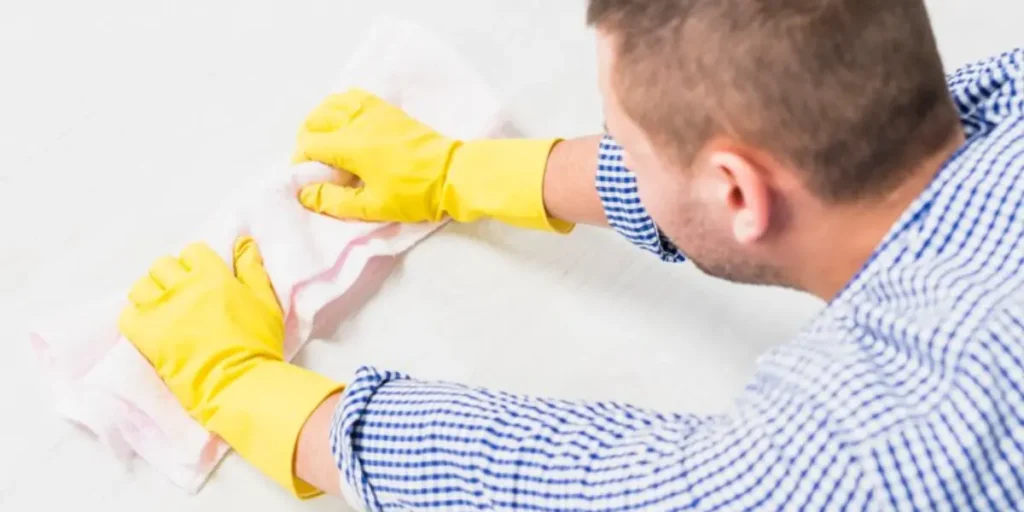Marble is a beautiful and elegant material often used for countertops, floors, fireplaces, and more. However, marble can stain or become dirty over time if not properly maintained. In this article, we will provide you with the complete guide on how to clean marble. We will share several effective methods to clean marble using common household items like baking soda and vinegar. Following the correct cleaning process is important to preserve the beauty of your marble surfaces for years to come.
How to Clean Marble Stains

One of the most common issues homeowners face with marble is stains. Marble is very porous, which means stains can soak deep into the surface if not addressed quickly. Here are some tips for how to clean marble stains:
- For oil or grease stains, mix baking soda and water to form a thick paste. Gently rub the paste onto the stained area using a soft cloth or non-abrasive brush. The baking soda will absorb the oil or grease from the marble. Rinse and dry thoroughly.
- For red wine or juice stains, make a paste of hydrogen peroxide and baking soda. Apply it to the stain and allow it to sit for at least 30 minutes before rinsing. The combination of hydrogen peroxide and baking soda is highly effective at removing organic stains from marble.
- For rust stains, use a cream cleaner or lemon juice. Apply it to the stain, let it sit, then scrub gently and rinse. Lemon juice is mildly acidic and can break down rust deposits on marble surfaces.
- For tough stains that baking soda cannot remove, try a pH-neutral marble cleaner or a poultice made of calcium carbonate. Consult with a professional restorer for guidance on deep-seated or set-in stains.
Following these tips on how to clean marble stains will help keep your marble looking new for years to come. Acting swiftly on spillages is key to preventing stubborn marks.
How to Clean Marble Floors
Marble floors require continuous maintenance to keep them looking pristine. Here are the best methods for how to clean marble floors properly:
- Sweep or dust mop floors regularly to remove loose dirt before wet cleaning. This prevents abrasive particles from grinding into the stone’s surface.
- Use a microfiber mop or clean mop head to damp mop the floor. Microfiber is gentler on marble than cotton or synthetic materials.
- For tougher residues like heel marks or ground-in dirt, spray cleaner directly on problem areas and let it sit a few minutes before scrubbing with a soft brush or non-abrasive scrubbing pad.
- Rinse the wet cleaning solution from the floor thoroughly with a clean damp mop until no traces of soap remain.
- For a polished shine, dry the floor completely and apply a marble polish or natural oil intended for sealed indoor floors as a finishing step.
With regular sweeping, damp mopping, and occasional deep cleaning, your marble floors will maintain their elegance with minimal effort. Special care must be given to properly how to clean marble floors to prevent damage over time.
How to Remove Stains from Marble with Baking Soda

Baking soda is one of the most effective and safest methods for how to clean marble. As an abrasive yet gentle cleaning solution, it helps dissolve stains and restore radiance without scratching delicate stone surfaces. Here are some simple ways to use baking soda to remove common marks from marble:
- To lift grease spots and dirt, make a smooth paste with 2-3 tablespoons baking soda and a small amount of water. Rub onto stained areas and let sit for 10 minutes before wiping clean with a damp cloth.
- For light scratches or water spots, sprinkle baking soda directly over marks and rub gently in a circular motion with a soft cloth. Buff away residue. May need to repeat stubborn blemishes.
- To get rid of scuffs, create a thicker paste with 1/4 cup baking soda mixed with a few drops of water or hydrogen peroxide. Clean marks with a soft brush or microfiber cloth, rinse, and buff dry.
- For tough jobs, fill a small bowl with baking soda and add just enough water to create a spreadable but still thick consistency. Pack paste onto areas and cover with plastic film overnight for deepest cleaning action.
By taking advantage of baking soda’s low abrasiveness and absorption power, it safely removes a variety of common issues that diminish marble’s beauty through regular use. How to clean marble has never been simpler or more budget-friendly.
How to Clean Unsealed Marble
If your marble surfaces are unsealed, extra precaution should be taken when cleaning to avoid etching or wearing down the stone’s surface over time. Here are some tips for how to properly clean unsealed marble:
- Spot test any cleaning products on an inconspicuous area first to check for chemical reactions. Unsealed marble is especially vulnerable.
- Always use a pH-neutral cleaner formulated for stone. Citrus-based cleaners can be too acidic for unprotected marble.
- Spot clean with a mild liquid dishwashing detergent or marble-safe cleaner instead of soaking surfaces. Flood wetting can seep below the surface.
- Avoid anything with harsh abrasives that may scratch. Stick to non-scratch sponges, brushes and microfiber cloths.
- Rinse thoroughly and blot dry with clean cloths instead of harsh rubbing. Wring water out of cleaning tools before continuing.
- Regularly sweep dust and dry dirt instead of frequently damp mopping. Too much moisture allows contaminants to penetrate.
- Consider sealing unsealed marble for extra protection when heavily used, especially on floors. Reseal every 2-3 years.
Taking special care with cleaning technique while the marble remains unsealed is key to how to clean it without incurring damage over time. Regular routine care will keep it looking its best.
How to Clean Marble With Baking Soda
Baking soda is one of the most gentle and effective ways to clean marble surfaces without using harsh chemicals or abrasives that could scratch the delicate stone. Here are the basic steps for how to clean marble with baking soda:
- Sweep or dust the marble surface first to remove loose dirt and debris. This will help minimize scratching during the cleaning process.
- Create a paste by mixing 2-3 tablespoons of baking soda with just enough water to reach a spreadable consistency.
- Spread the baking soda paste onto the marble surface using your finger, the edge of a coin, or a clean sponge or cloth. Be sure to coat any visibly dirty or stained areas.
- Allow the paste to sit on the surface for at least 15 minutes in order to draw out dirt, oil, residue and stains through its absorption properties.
- Buff the soiled areas gently using light circular motions with a clean, slightly dampened cloth or soft brush. Baking soda is non-abrasive but may need some rubbing for tough builds up.
- Rinse away any residue with clean water and dry thoroughly with a clean lint-free cloth.
- For added shine, seal the freshly cleaned marble with a natural oil or sealant recommended for the surface once fully dry.
Proper how to clean marble with baking soda restores its radiance without risk of scratching or itching thanks to this kitchen staple’s mild cleaning action. Try it for safe, affordable routine care.
How to Clean Marble With Vinegar
Vinegar makes an effective natural cleaner for marble when used in moderation. Its acidity helps dissolve stubborn stains and mineral deposits left behind by hard water. Here is a step-by-step method for how to deep clean marble with vinegar:
- Sweep away any loose dirt first to avoid scratching the surface during cleaning.
- Mix equal parts white vinegar and lukewarm water in a spray bottle. The solution should be slightly acidic, not overpowering.
- Spray the vinegar solution directly onto problem spots and stubborn stains. Let it sit for at least 5 minutes to work.
- For heavy-duty cleaning, lay down plastic sheeting underneath the stained area and saturate with undiluted white vinegar. Cover securely and let sit overnight.
- With a clean sponge or soft-bristled brush, gently scrub the treated areas in gentle circular motions. Spot test in inconspicuous areas first if unsure about surface hardness.
- Rinse away residues thoroughly with clean water until no vinegar smell remains. Wipe or rinse areas until completely dry.
- Apply a light natural oil polish formulated for your type of marble as the final step to restore luster and protection.
Be cautious not to overuse vinegar’s acidity, as prolonged exposure can dull marble over time. For how to clean marble deeply yet safely, try diluted white vinegar in moderation for its grease-cutting powers. Always do a patch test first.
How to Protect Marble After Cleaning
No matter which method you use for how to clean marble, it’s important to lock in your hard work with a protecting sealer or natural polish. Here are some product recommendations:
- For polished marble surfaces like countertops, try butchers block oil or mineral oil. These natural oils enhance shine without altering appearance. Reapply periodically.
- On floors, use a pH-neutral impregnating sealer that works its way into pores to safeguard against dirt and spills. Reapply every couple years with regular floor cleaning.
- For acid-sensitive marble, look for sealers with cationic polymers that bond well without changing the stone’s look or porosity.
- High-traffic areas may need weekly polishing with a marbled marble polish to maintain a lustrous barrier against stains and moisture.
- While allowing it to fully dry, keep cleaned areas out of direct sunlight and high-traffic zones to prevent moisture absorption before sealing.
Proper sealing is crucial as the final step in any marble cleaning process. It helps keep the elegant stone looking pristine with less maintenance required between thorough cleanings.
Conclusion
We hope this comprehensive guide provided all the information needed on how to properly clean marble. Following the methods outlined here using gentle, pH-neutral cleaners and homemade remedies like baking soda will allow you to safely maintain your marble’s pristine beauty for years to come.
Feel free to reach out if you have any other questions. SF Marble Granite experts are happy to assist with specific stains or issues affecting your marble surfaces.
Contact us
Email: sfmarbleangranite@gmail.com
Phone: 978-459-582
Address: 755 Dutton St. Lowell- 0185MA4
FAQs
Can I use bleach to clean marble?
No, bleach is too harsh and will damage marble through etching over time from its high acidity. Natural cleaners are safest.
What is the best way to remove mildew from marble?
Make a paste with 3 parts baking soda to 1 part hydrogen peroxide. Apply and let sit for 10 minutes before scrubbing and rinsing. The fizzing reaction helps eliminate mildew.
How do I remove hard water stains from marble?
Mix a solution of 2 tbsp citric acid and 1 quart of warm water. Wet the stain and let sit for 5-10 minutes before scrubbing gently. This process may need to be repeated for stubborn deposits.
Can marble surfaces be washed in the dishwasher?
It’s generally not recommended to wash real marble items in the dishwasher due to extreme temperature fluctuations and jet spray that can degrade the stone over many cycles. Hand washing is better.
How often should marble be sealed?
Most experts recommend reapplying a fresh coat of sealer to polished marble surfaces like countertops every 1-2 years for optimal protection with regular cleaning and use. High traffic areas may need more frequent resealing.

